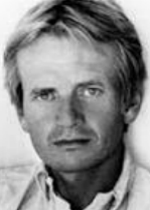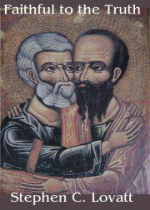Queer Rites: November 2012
Author: Thom Nickels
November 20, 2012
While reading Salman Rushdie’s Joseph Anton, the story of Rushdie’s life in hiding after he was “sentenced to death” by the Ayatollah Khomeini on February 14, 1989—a book that I am still reading, but slowly, because I am not all that enamored with Rushdie’s style—I came across a reference to English writer Bruce Chatwin. Chatwin, born in 1940, was an English novelist and travel writer and one of the most prominent people in Britain to die of HIV-AIDS in 1989. As a young man, Chatwin worked at Sotheby’s in London until he contracted an eye problem, at which point his interests began to turn towards archaeology. Although gay, he married Elizabeth Chanler, a descendant of John Jacob Astor, in 1965. Their marriage was celibate, according to Chatwin’s biographer, Nicholas Alexander. Chatwin, in fact, was never open about his homosexuality or even about his contracting HIV-AIDS, a disease he kept secret or passed off as a fungal infection caused by a monkey bite. He also claimed that he contracted the disease from a gang rape or a possible transmission from Sam Wagstaff, Robert Mapplethorpe’s lover.
Chatwin was a spectacularly good looking blond Nordic type with a slender frame that never failed to get people’s attention. It is said that when he walked into a room all eyes turned to him. Here was not only beauty but beauty with substance and brains. The author of nine books, including Patagonia (1977) and On the Black Hill (1982), Chatwin called himself a nomad and wrote that a nomad never has to worry about finding God or the finality of death, because the act of moving wards off all such concerns.
As a writer, Chatwin rarely mentioned God or played up any interest in spirituality. In fact, he is often remembered for the following quote: “I haven’t got any special religion this morning. My God is the God of Walkers. If you walk hard enough, you probably don’t need any other god.” But when he traveled to Mount Athosto visit a monastery and observe the daily lives of Orthodox monks, he was struck by the sight of a large iron cross in the rocks overlooking the sea. When he saw the cross, he stopped dead in his tracks. He knew instantly that his nomadic non-spiritual days were over. He soon made plans to convert to the Orthodox Christian faith, and wanted Metropolitan Kallistos Ware, a convert to Orthodoxy from Anglicanism, to baptize him. Death intervened before that could happen, but Chatwin was given an Orthodox funeral at Saint Sophia Church in London, attended by Rushdie and a number of writers from the United States and Britain.
Rushdie, in a similar satirical tone that landed him in hot water with the Ayatollah (The Satanic Verses), describes Chatwin’s funeral Liturgy this way:
“…Its rituals were ornately Byzantine. Blah blah blah Bruce Chatwin, intoned the priests, blah blah Chatwin blah blah. They stood up, they sat down, they knelt, they stood and then sat again. The air was full of the stink of holy smoke.” Rushdie called the Liturgy Chatwin’s last great joke.
But it was no joke.
Rushdie, who as a boy was taken by his father to a mosque where there was “a good deal of up-down forehead bumping, and standing up with your palms held in front of you like a book, and much mumbling of unknown words in a language I didn’t speak,” comes from a place where religion is antithetical to the life of the mind. Call it the Ayn Rand School of Disembodied Theology, the “I only believe in me” world that many intelligent people inhabit.
Intellectuals like Rushdie, then, become nervous when their peers “find religion” or alter old agnostic courses for new “believing ones.” They either react with bemused tolerance, skepticism (“It has to be a joke”) or outright hostility, as Virginia Woolf did upon hearing of T.S. Eliot’s conversion to Anglo-Catholicism. Virginia Woolf, in fact, was not amused at her friend transition, but in fact became very angry. She even predicted that Eliot would “drop his Christianity with his wife, as one might empty the fishbones after the herring.”
Recently I attended a panel discussion on Science and Secularization at the Chemical Heritage Foundation in Philadelphia. Panelists included John H. Brooke, a Professor of Science and Religion at Oxford University; Ronald L. Numbers, a Professor of the History of Science, Medicine and Religious Studies at the University of Wisconsin; and John M. Templeton, Jr., a retired pediatric and critical care surgeon. Templeton reminded the audience of a clause in the Hippocratic Oath that the first duty of a physician is toward the patient, a fact that he says is increasingly forgotten today.
Taking the path of secularization and atheism to its utmost extreme, Templeton asked the audience if they thought it would be a good thing if physicians looked upon their patients as “just a bunch of chemicals.” Conversely, Templeton asked if patients would want themselves to be perceived as “just a bunch of chemicals.”
The assumptive answer among the group of science-friendly audience members was a silent but resounding No.
A Facebook friend of mine in England sent me his book, Faithful to the Truth: How to be an orthodox gay Catholic (Create Space). It arrived on my doorstep the same day as Martha Shelly’s novel, The Throne in the Heart of the Sea (Ebisu Publications).
These are two books with two very different themes. Generally, Queer Rites doesn’t “review” novels (this will not be a review, but a sort of grandiose notice) but an exception must be made in Shelly’s case because of her iconic status as one of the founders of New York’s Gay Liberation Front. Having been a member of Boston GLF myself, I remember traveling to Washington, D.C. for the 1970 Black Panther Revolutionary Peoples’ Constitutional Convention with other Boston GLFers when, on the journey back, we stopped in New York City to visit Christopher Street and the Village. In between walking the streets while holding hands we stopped at a restaurant for lunch when somebody in our group pointed out that the person sitting at a nearby table was none other than Martha Shelly.
“Martha Shelly!” we gasped.
Martha Shelly was a legend even then.
“About thirty years ago,” Shelly writes in the novel’s Afterword, “I was trying to gain perspective on my own life and contemporary problems by studying history—specifically the history of my people. It was then that I discovered Jezebel, and decided to write about her.
“If you ask most people who Jezebel was,” Shelly continues, “they will say a bad woman, meaning a sexually immoral one. They won’t know that she was a queen, or where she reigned, or what gods she worshipped. They are even less likely to know the story of her arch-enemy, Elijah the Prophet.”
Shelly believes that “Elijah’s partisans” helped to slander Jezebel’s name for all time, although she also notes that “The only proof we have of Jezebel’s existence is her seal stone [reproduced in the book as it is currently displayed at the Israel Museum,Jerusalem].” Shelly goes onto to say that although it is quite certain that Elijah was a real person, “We cannot be absolutely certain.”
Elijah, of course, is a prophet for all seasons, since for Christians [as Shelly notes] he foretold the coming of Jesus, “and that his spirit and power returned in the person of John the Baptist.” Believing (non-secular) Jews, on the other hand, expect Elijah to return to earth to announce the coming of the messiah.
For writer Judy Grahn, author of Blood, Bread and Roses, Shelly’s novel is a “sensuous historic novel of 9th century BCE,” where the “power relations among the three main characters unfold in cliff-hanging episodes.”
*
Stephen C. Lovatt’s book, Faithful to the Truth, is unique in that here we have a Traditionalist Catholic who believes that Vatican II did much to destroy traditional liturgical practices in the Catholic Church. Most apologists for lgbt voices in the Catholic Church today come from the Novus Ordo or the liturgically liberal wing of Catholicism. Almost all Dignity USA Masses, for instance, are ultra-modern versions of what in the late 1960s was called the “New Mass,” a Mass that even today seems more Protestant than Catholic. Lovatt, in his Preface, states: “…Orthodoxy is not the same thing as Conservatism or of servile obedience to the decrees of any particular pope.” Furthermore, Lovatt goes onto say that “the repressive policies of the modern Magisterium are not supported by a careful, dispassionate and open-hearted reading of the Church’s Tradition.”
For Lovatt, Pope Benedict XVI is not quite the total bogeyman that secularists make him out to be, if only because he had the intelligence to realize that the use of a condom could be justified as the lesser of two evils when it comes to the risks of infecting a partner during sexual intercourse, even though the act of intercourse may already be sinful in the eyes of the Church. Lovatt sees this papal proclamation as a blurring of the “rigid ‘natural is wholesome versus unnatural is depraved’ dichotomy,” and adds, “There is no telling what else will eventually follow from this adjustment of perspective.”
But don’t hold your breath.
Lovatt, of course, follows familiar Scriptural ground, beginning with the Jewish Testament prohibitions against homosexuality and then focusing on well known Christian Testament prohibitions. But unlike many other lgbt historian/theologians, Lovatt quotes extensively from the writings of early Church Fathers, a welcome addition to the usual focus on standard biblical injunctions.
When it comes to homosexuality and the Church, the problem for lgbt Catholics is the current attitude of Rome. Think about it: the Church won’t even dialog with its lgbt members despite the ecumenical inroads (and some say, abuses) it has made in the last few decades: Papal audiences with Voodoo witch doctors and their topless female counterparts, pagans that would have been burnt at the stake just a few centuries ago. Consider John Paul II’s visit to a mosque and his kissing of the Koran and calling it a holy book, an ecumenical gesture of radical magnitude far surpassing heretofore tea and sympathy relations with mainstream Protestants and the Jews.
But when it comes to dialog or ecumenical relations with homosexuals, there has been nothing but clear cut condemnation, a situation that might been seen ultimately as partially as defensive rhetoric in the wake of the worldwide clergy sex abuse crises.
Lovatt wants to make it clear to Catholics that arguing or disobeying the pope is not any kind of ultimate sin. “Saint Paul stood up to Saint Peter, the first pope and his hierarchical superior, over the matter of the equality of uncircumcised gentile within the Church,” he writes.
And: “Saint Catherine of Sienna admonished Gregory XI, in no uncertain terms…regarding the reform of the Church and when Gregory proved ineffective, she told him that he should resign.”




